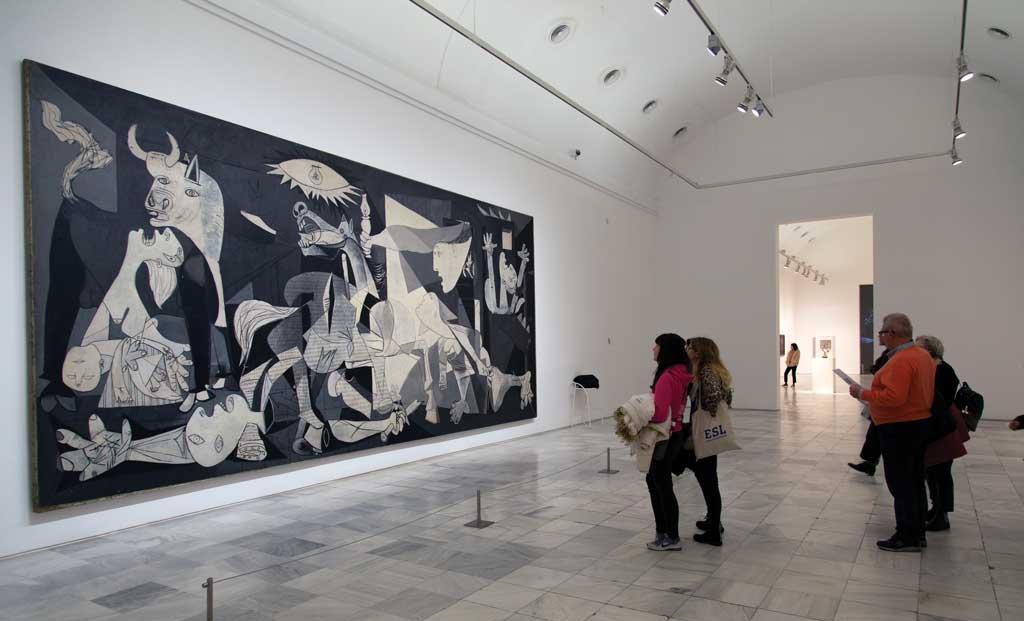Many people consider Guernica to be Picasso's greatest work of art. Indeed, it is a world-famous masterpiece of anti-war themes.

Tourists admiring Picasso's masterpiece Guernica
Let's first understand the background of this painting:
In 1936, a civil war broke out in Spain. One was the Franco rebels, who colluded with the German fascists to impose a reign of terror on the country; the other was the republican faction that supported the government.
On April 26, 1937, the day of the market in the small town of Guernica in the Basque Country of Spain, the streets were crowded with simple local residents. In the afternoon, Franco ordered the German Vulture Corps to bomb the area. Bombers and fighter jets continued to bomb the town for 3 hours, leveling half the city and killing more than 1,600 innocent people unarmed.
The Spanish town of Guernica after being bombed
When the news came, the whole world was shocked. Picasso began working on Guernica on May 1, and after only five weeks, he completed this masterpiece that is nearly 8 meters long and 3.5 meters high.
Picasso creates Guernica in the studio
Let's take a look at the painting next: the whole picture is only black and white, and the characters and animals on the picture are hideous and open-mouthed, and through the canvas, we seem to be able to hear their screams of fear. Picasso used his Cubist technique to vividly express the fear and chaos caused by the explosion.
Picasso Guernica, 1937 Oil on canvas, 349.3×776.6 cm, Museo Nacional des Arts, Reina Sofia, Madrid, Spain
This is the woman trapped in the war on the lower right side of the picture. She stretched out her arms to the sky for help, while in the lower left of her, another woman dragged her injured leg, perhaps looking for surviving relatives in the rubble.
Part of Picasso's Guernica
On the screen, in order to show the pain of innocent people under the war, the hands are deformed, the woman's eyes are teardrop-like, and the tongue is pointed, like a ruthless dagger. See the three partial maps below.
In this part of the picture above, the grief-stricken mother holding her dead son and crying hoarsely to the sky is reminiscent of the "Virgin Of Mercy" crucifixion gesture common in painting art. The mother's twisted body, open fingers, and open mouth enhance the emotional impact effect.
Looking at the mother and son who suffered was this expressionless and indifferent cow. Picasso once said, "This cow represents cruelty and darkness."
Picasso originally painted a sun in the painting, which was later changed to an eye with a light bulb in the middle. The light bulb is "bombilla" in Spanish and is very similar in spelling and pronunciation to the Spanish word "bomba" which means "bomb".
This ghost-like figure, a woman holding an oil lamp, seems to illuminate the noisy picture. This is reminiscent of the Statue of Liberty standing in New York, which may be a hope that Picasso left in the picture.
Picasso also drew a little hope that a fragile little flower was stubbornly opening.
After Picasso completed this "Guernica", he never set foot in Spain and finally died in France. But he hopes guernica will return to his native Spain after his death. Today, Guernica is in the collection of the National Art Center Museum of Queen Sofia in Madrid, Spain.
Picasso, Guernica, 1937
Painter Wang Yancheng at the Picasso Museum in Paris
The "Yan" say Picasso series will tell the story of Picasso's modern art path through 25 representative works of different periods of Picasso's life, so please continue to pay attention to it.